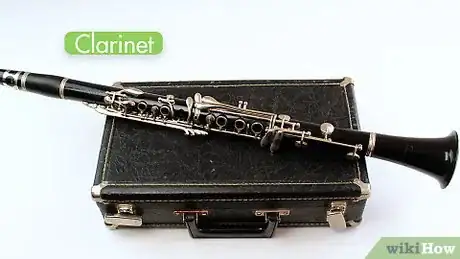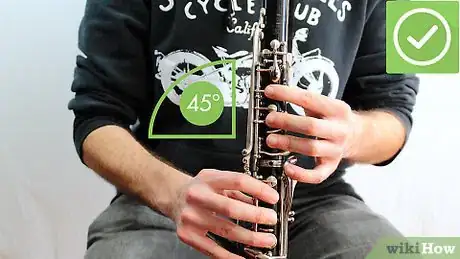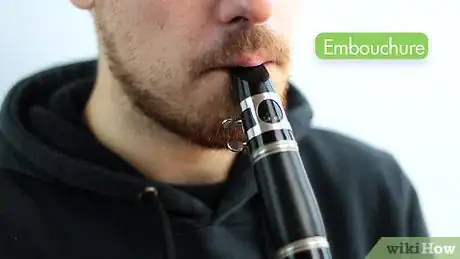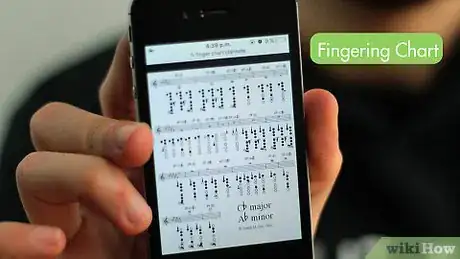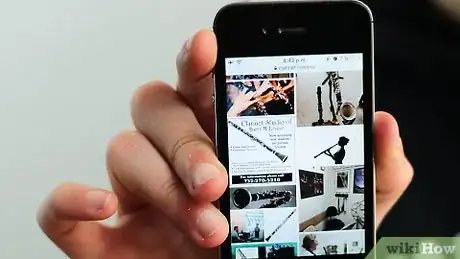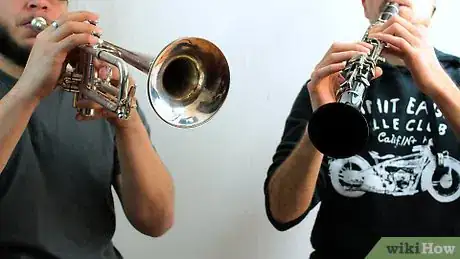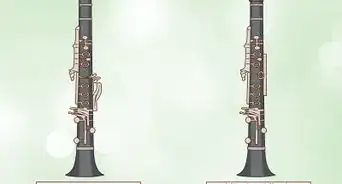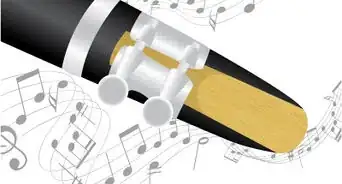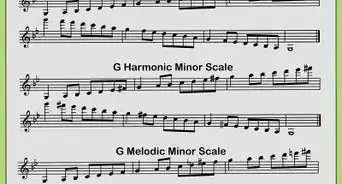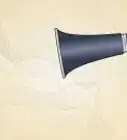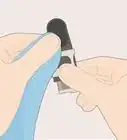wikiHow is a “wiki,” similar to Wikipedia, which means that many of our articles are co-written by multiple authors. To create this article, 152 people, some anonymous, worked to edit and improve it over time.
There are 7 references cited in this article, which can be found at the bottom of the page.
The wikiHow Video Team also followed the article's instructions and verified that they work.
This article has been viewed 571,069 times.
Learn more...
A clarinet is a woodwind instrument with a beautiful, pure sound. Clarinets have one of the largest ranges of pitch of all musical instruments, making it one of the most interesting instruments to play. Whether you're learning with a school band or on your own, there is a lot to learn. It is important to learn how to assemble the instrument, hold it properly, make an even tone, and get started learning to play the right way.
Steps
Learning the Instrument
-
1Get a clarinet appropriate for your purposes. If you're just starting out for school band, it's common to rent a clarinet from the school, or from a music shop in your town. It's much easier to learn on a properly maintained instrument that's new, instead of one that's been sitting in the attic gathering mildew. It's also a lot cheaper than buying a new model.
- If you're a beginner, a plastic clarinet is recommended. A Buffet B12 or Yamaha 255 are both popular models, but stick to a plastic first instrument as wood clarinets can be more difficult to play and maintain. It's usually common to use a soft reed; 2 to 2 and a half will most often work. You can use higher strength reeds (like a 3 or 4) once you have been playing for a while.[1]
- Avoid no-name clarinets (clarinets from manufacturers that aren't very common). Professional clarinets players and repairers tend not to have good things to say about clarinet brands they haven't heard of.
- If you have an old clarinet you want to use, take it into a music shop to get it fixed up. The pads will likely need to be changed, to make sure you get a clear tone from the horn.
-
2Inspect the clarinet and learn the names of the parts. Most clarinets come in carrying cases, with fitted slots for each component of the instrument. When it's time to take it out and put it together, inspect the case to make sure you've got all the parts ready to go in good working order.[2] The pieces are assembled from bottom to top, in the following order:
- The bell is the bottom component of the horn, and it fans out like a megaphone.
- The bottom stack makes up the main body of the clarinet, and it will have a cork connection piece on only one end of the section.
- The top stack makes up the other major section of the main body of the clarinet, and will have cork on both ends of the section. Line up the straight metal hinge on both pieces to orient the barrel properly.
- The barrel should be a short piece, 3-4 inches long, and slightly more flared at one end than the other.
- The mouthpiece is the top-most section of the instrument, and should come with a metal or leather ligature, which is used to hold the reed in place. Line up the bottom of the mouthpiece with the long straight octave key on the instrument.
Advertisement -
3Assemble the mouthpiece and reed properly. Slide the reed between the ligature and mouthpiece, with the flat part facing in. Tighten the nobs on the ligature until it's tight enough to stay on. When taking the clarinet part be careful not to let the screws fall out; they are extremely hard to get back in. Over-tightening can strain the mouthpiece, so be gentle.
- Don't put the reed higher than the mouthpiece, which makes it extremely difficult to produce a note. The tip of the reed should fall even with the tip of the mouthpiece.
- The tip of the mouthpiece is very fragile. So make sure to cover it with a mouth piece guard when not in use.
-
4Hold the clarinet properly. The clarinet should be held away from yourself, at a 45 degree angle, the bell just past your knees. Keep your head up and your back straight when playing. The clarinet should come to your mouth, your mouth shouldn't go to the clarinet.[3]
- The clarinet should be held with your right hand on the bottom stack, your thumb on the thumb-rest on the back of the stack. Your other three fingers should rest on the three corresponding keyholes.
- Your left hand should hold the instrument on the top stack. Your thumb should rest on the octave key on the back of the instrument. Your other three fingers will rest on the three main keys on the bottom of the top stack.
- When your fingers are not in use, keep them very close to the holes to make it easier for them to get to the keys when they are needed. If you keep your fingers too far away from the clarinet, it will make it difficult to play fast things.
-
5Wet the reed before you play. If you try to play on a dry reed, it will sound bad and will probably squeak more often. Before a performance or practice session, place your reed in a small jar or wet with saliva.
- Try to start with a softer reed, between sizes 1 and 2.5. As your mouth muscles get stronger, you will start needing harder reeds.
- You will know when to bump up reeds when your clarinet starts sounding like a person talking with their nose plugged. Your teacher will also tell you if you need a softer or harder reed.
-
6Disassemble and clean the clarinet after each use. Every time you play your clarinet, you need to take it apart and clean it to keep moisture from accumulating inside the horn. You can clean the instrument fairly quickly and easily.[4]
- Most horns should come with a cleaning rag, which you can draw through the body of the horn after each use. One end should have a string attached, which you use to pull through each section of the horn. It only takes a minute, but helps to keep your horn in good working order.
- Every now and then, it's also good to use a Q-Tip to clean around the connection points, where little particles and saliva can accumulate.
- Grease your corks regularly. It can make it hard to put together and take apart your clarinet if you let the corks dry up. Once you play your clarinet a lot you can grease the corks about once a week. If you grease the corks too much they may slide off.
Playing a Note
-
1Put the horn in your mouth properly. Say "whee" and while holding this shape, say "too". Hold this shape (known as your embouchure) and put the clarinet in your mouth.
- Keep your jaw flat. Your top teeth should be planted firmly on the top of your mouthpiece, opposite of the reed side.
- If you just push the horn into your mouth and blow, it'll be hard to make a note. It takes a little work in making the right shape with your mouth, called the embouchure.
-
2Seal the corners of your mouth around the mouthpiece. If your lips aren't sealing it enough, air will escape and no sound will come out. Try to lift the corners of your mouth to tighten it even more. Your tongue should be pointing at the reed when you play, but not touching it.[5]
- This may be hard to get used to at first and you will probably learn it best by taking lessons.
-
3Try to get an even tone. With your mouth properly position, just try to blow to make a tone. Experiment with different strengths of breath, and get a sense of how much it takes to get a good-sounding tone from the horn. It'll take some work. With no keys pressed, you'll play an open G on the clarinet.
- If you squeaked, don't be discouraged. It's hard to get used to the clarinet mouth shape. Just keep trying, and experimenting with different amounts of air to put through the horn.
-
4Keep your cheeks tight. It can be tempting to puff out your cheeks when you play, but you'll get a more even and consistent tone if you avoid this. Practice playing in the mirror to avoid puffing them out.[6]
- At first, this may make you squeak much more. If you squeak a lot, check where your mouth is on the mouthpiece. Make sure it is not too high or low on your mouthpiece. Your teacher can help you with this. Also make sure your reed is lined up correctly.
-
5Try to play a few notes. Push down some keys to experiment with different notes, seeing how it changes the strength that you need to use to blow through the horn. try to get a sense of what makes the sound go higher and lower. Just play around for a while.
- When you are playing, always cover the holes completely. If you don't, the notes won't come out. Especially when you are using the register key, be sure that all holes are covered completely.
Taking the Next Step
-
1Get a fingering chart. Check out your local music store again and see what kinds of beginner clarinet books they have. Some commonly used ones are Band Expressions, Standard of Excellence, and Rubank Elementary Method. All of them will teach you how to play songs and learn the proper fingerings for each note.[7]
- It'll be hard to go very far on clarinet without learning to read sheet music. The clarinet is a treble-clef instrument in the Bb range, so you'll need to learn the basics of the treble clef to learn more about playing the instrument. The best way to do this is usually school band or private lessons.
-
2Practice scales and arpeggios. If you practice scales and arpeggios, your technique for solos and other repertoire will be much smoother. Finger patterns are essential for playing clarinet well, and you can learn those quickly by practicing these runs.
- These will probably be taught to you eventually by your teacher eventually, if you have one.
-
3Learn songs. As with any instrument, if you're just playing for fun, start off with things you know. There are plenty of popular pieces for the clarinet that are not too challenging. This is especially so if you like swing and jazz, which is more intuitive. The classical repertoire can be more demanding, but there are easier pieces here if you look hard enough.
-
4Consider taking private lessons. It's very hard to learn to play clarinet just from reading a book. It's best to start out with a teacher instead of on your own so that you won't miss anything or learn anything wrong. Often, school music teachers will offer lessons for cheap.
- Bad habits can develop without you even knowing, which can make it hard to get past a certain skill level. If you want to play clarinet the right way, take lessons.
-
5Join your school band or orchestra. If you are truly interested in playing the clarinet, find a teacher and join a band or orchestra.
- Prepare for the long haul! You aren't going to become a good player overnight. Start with the basics then move on to more advanced things. Playing an instrument is a life-long learning project.
Community Q&A
-
QuestionWhy does my clarinet make no sound when I blow into it?
 Community AnswerYou might be playing on a broken or old reed, so if you can, get a new one. If your reed is not the problem, it might be that you are not covering the holes on your clarinet completely. Try to move your fingers on the holes in a different way (i.e. rotating them differently or arching them) to fix this problem. You will also want to check that you have the proper embrochure, as this could cause a problem as well. If none of these fixes work, take your clarinet into a music store for a "check up," as something may need to be repaired.
Community AnswerYou might be playing on a broken or old reed, so if you can, get a new one. If your reed is not the problem, it might be that you are not covering the holes on your clarinet completely. Try to move your fingers on the holes in a different way (i.e. rotating them differently or arching them) to fix this problem. You will also want to check that you have the proper embrochure, as this could cause a problem as well. If none of these fixes work, take your clarinet into a music store for a "check up," as something may need to be repaired. -
QuestionI used to be very good at clarinet, but after not playing for months I lost it. Any advice?
 Community AnswerTry picking up beginner books and re-learn it. Then occasionally practice so you keep improving and don't lose it again.
Community AnswerTry picking up beginner books and re-learn it. Then occasionally practice so you keep improving and don't lose it again. -
QuestionWhy is it important to clean the clarinet after playing?
 Community AnswerCleaning the instrument after playing it ensures that the instrument will have a long lifetime and will not harbor bacteria that can make you ill. If it is not cleaned out after use, moisture can accumulate inside and produce mold and other bacteria. Make sure you clean the mouth piece of the instrument as well.
Community AnswerCleaning the instrument after playing it ensures that the instrument will have a long lifetime and will not harbor bacteria that can make you ill. If it is not cleaned out after use, moisture can accumulate inside and produce mold and other bacteria. Make sure you clean the mouth piece of the instrument as well.
Warnings
- Never chew gum or eat/drink sugary things while or before playing! The food can get in your clarinet or your spit can dry up inside of it and make it sticky inside of there.⧼thumbs_response⧽
- Don't bite down too hard on the mouthpiece. This can damage the mouthpiece and make your teeth hurt.⧼thumbs_response⧽
- Clarinet is a very difficult instrument to learn how to play well without a teacher. It may be easy to get started, but unless you want to be stuck on beginner music forever, it may be best to get a teacher.⧼thumbs_response⧽
- Don't ever try to fix a Clarinet by yourself, get help with your teacher or go to the music store.⧼thumbs_response⧽
Things You'll Need
- A ligature
- Cleaning swab or cloth
- Cork grease
- Bore oil (for wooden clarinets)
- A music book to help you get started
- Teacher or friend (optional, but a teacher will know the techniques best)
- Clarinet case
- A pencil to write in beats, notes, etc. that you have trouble with in your music
- red stamp (for wooden clarinets)
- A reed (beginners-2 1/2 or 3)
- Water in a bottle or jar
- A tuner to make sure your clarinet is tuned
- A metronome to keep beat to a certain song
- A reed case
- Mouth Piece Cap
References
- ↑ https://www.amromusic.com/step-up-clarinets
- ↑ https://www.youtube.com/watch?v=wTHftAV-5FE
- ↑ http://www.the-clarinets.net/english/clarinet-how-to-play.html
- ↑ http://thevault.musicarts.com/clarinet-maintenance-care-tips-advice/
- ↑ https://www.dansr.com/vandoren/resources/clarinet-tonguing-tips-with-david-gould
- ↑ http://www.the-clarinets.net/english/clarinet-how-to-play.html
- ↑ http://www.woodwind.org/clarinet/YPP/Craig.html
About This Article
The fastest way to play the clarinet is to hold the top stack with your left hand and the bottom with your right, while placing your fingers on the respective keyholes. Put the mouthpiece in your mouth and blow air into the instrument, while keeping the corners of your mouth tight. To learn how to prepare your clarinet for playing and advance your skill set, scroll down!
